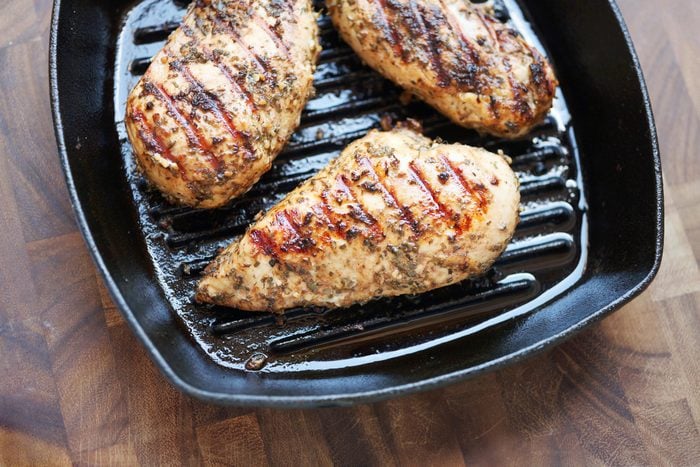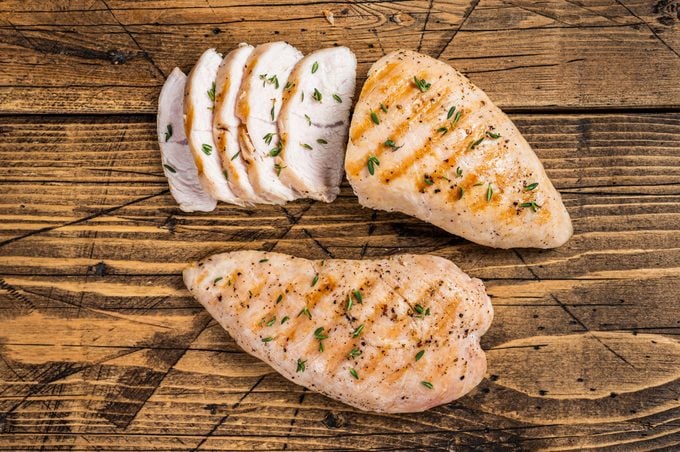If You See White Stuff Coming Out of Your Chicken, This Is What It Means
Updated: Jan. 29, 2024

What is that white stuff coming out of chicken when you cook it—and is it safe to eat? Here’s what the experts say.
If you regularly cook chicken, you’ve no doubt encountered “the white stuff.” Or, more accurately, you’ve pulled a chicken breast out of the oven and yelped, “What the heck is that?!” You wanted your chicken to look delicious, and for some reason, it’s oozing a mysterious white … goo? Juice? What, exactly, is that white stuff coming out of chicken?
As a professional food writer, cookbook author, chef and cooking instructor, I have answered more culinary questions than I can count. And this food fact is no exception—especially since this ooey-gooey phenomenon occurs so frequently. Drew Curlett, a Baltimore-based personal chef and culinary instructor, agrees: “It might not be pretty, but it’s pretty normal to see white stuff come out of chicken, especially when baked or roasted.” Read on to find out what it is—and if it’s safe to eat.
Get Reader’s Digest’s Read Up newsletter for more food facts, cleaning, humor, travel, tech and fun facts all week long.
About the expert
|
What is that white stuff oozing out of your chicken?
Chicken is a protein powerhouse, so it shouldn’t be surprising that the white stuff coming out of chicken as it cooks is exactly that: protein! According to chicken farmer Paul Greive, founder of Pasturebird, this naturally occurring, water-soluble protein is called albumin. It can also be found in meat, milk and eggs.
To understand how this invisible protein turns into the white stuff on chicken, it’s helpful to imagine its presence in eggs—specifically egg whites, which are primarily made of water and proteins. Think of how they’re clear when raw, but turn white after they’re cooked. This is because the proteins coagulate, changing the color and transparency. Well, the same thing happens with some of the juices in chicken.
Just like eggs, the juices inside raw chicken are also made of water and protein. Meat contracts as it cooks, squeezing out some of the liquid inside it. “In a pan or on the grill, most of this liquid evaporates when it comes in contact with high heat,” says Curlett. “But in an environment like a conventional oven, this liquid pools and cooks through. It’s really common when cooking at high heat without much in the way of liquid or fat, like if you’re baking plain, boneless, skinless chicken breasts.”
When does this white stuff appear most frequently?
The occurrence of white stuff doesn’t have as much to do with cooking method as it does with storage. When chicken is frozen, the water inside of it turns into jagged ice crystals that can puncture cell walls, and cells are full of water and protein. When thawed, the liquid contents of ruptured cells drain into the spaces between muscle fibers. And when the chicken is cooked, some of this liquid will inevitably be pushed to the surface, as the meat tightens.
Is the white stuff safe to eat?

Yes, the white stuff in chicken is safe, according to Greive and Curlett. The white stuff on the outside of your chicken is the same juices you’ll find inside, which are perfectly safe to eat. Don’t worry—your chicken has not gone bad!
As for how it tastes, the white stuff doesn’t have much in the way of flavor. In small amounts, you probably wouldn’t notice that you were eating it at all. But larger puddles of it can have a jelly-like or rubbery texture that some people find unappealing. Still, it’s safe to eat.
Does this happen with any other types of meat?
Albumin is found in all animals, so it’s entirely possible for white stuff to come out of any meat you’re cooking. However, you’ll most commonly see it in cuts that have been previously frozen. The best seafood is flash-frozen shortly after it’s caught to preserve freshness, so it’s common to see white stuff coming out of salmon, shrimp and other fish. You’ll also often see white stuff coming out of items made of ground meat, like burgers or sausages.
How can you avoid that white stuff when cooking chicken?
Though the white stuff is entirely natural, it’s not exactly attractive. Cooking lower and slower helps to minimize it, as high heat causes meat to contract rapidly and tightly—and subsequently squeeze out albumin. Gently cooking chicken at a lower temperature will take longer, but will also lessen the amount of white stuff that comes out of it. When baking or air-frying, try lowering the temperature by 25 degrees, and use a meat thermometer to help adjust the cooking time accordingly. Another way to avoid encountering the white stuff on chicken is by using fresh chicken, not frozen.
Sources:
- Drew Curlett, personal chef, caterer and culinary instructor; email interview, January 2024
- Paul Greive, chicken farmer and founder of Pasturebird; email interview, January 2024
- Kitchen Smarts: “Questions and Answers to Boost Your Cooking IQ”
